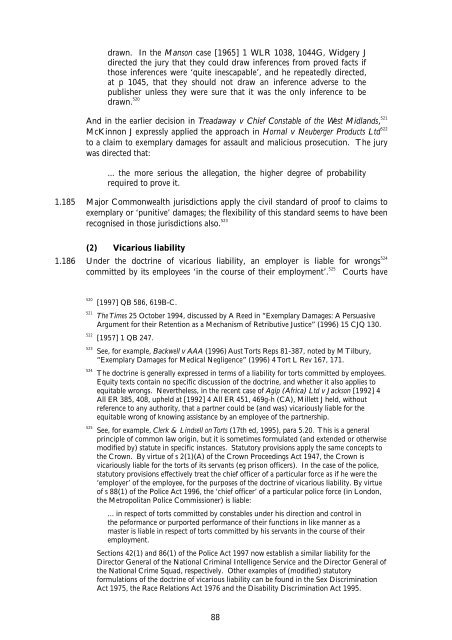Aggravated, Exemplary and Restitutionary ... - Law Commission
Aggravated, Exemplary and Restitutionary ... - Law Commission
Aggravated, Exemplary and Restitutionary ... - Law Commission
Create successful ePaper yourself
Turn your PDF publications into a flip-book with our unique Google optimized e-Paper software.
drawn. In the Manson case [1965] 1 WLR 1038, 1044G, Widgery J<br />
directed the jury that they could draw inferences from proved facts if<br />
those inferences were ‘quite inescapable’, <strong>and</strong> he repeatedly directed,<br />
at p 1045, that they should not draw an inference adverse to the<br />
publisher unless they were sure that it was the only inference to be<br />
drawn. 520<br />
And in the earlier decision in Treadaway v Chief Constable of the West Midl<strong>and</strong>s, 521<br />
McKinnon J expressly applied the approach in Hornal v Neuberger Products Ltd 522<br />
to a claim to exemplary damages for assault <strong>and</strong> malicious prosecution. The jury<br />
was directed that:<br />
... the more serious the allegation, the higher degree of probability<br />
required to prove it.<br />
1.185 Major Commonwealth jurisdictions apply the civil st<strong>and</strong>ard of proof to claims to<br />
exemplary or ‘punitive’ damages; the flexibility of this st<strong>and</strong>ard seems to have been<br />
recognised in those jurisdictions also. 523<br />
(2) Vicarious liability<br />
1.186 Under the doctrine of vicarious liability, an employer is liable for wrongs 524<br />
committed by its employees ‘in the course of their employment’. 525<br />
Courts have<br />
520 [1997] QB 586, 619B-C.<br />
521 The Times 25 October 1994, discussed by A Reed in “<strong>Exemplary</strong> Damages: A Persuasive<br />
Argument for their Retention as a Mechanism of Retributive Justice” (1996) 15 CJQ 130.<br />
522 [1957] 1 QB 247.<br />
523 See, for example, Backwell v AAA (1996) Aust Torts Reps 81-387, noted by M Tilbury,<br />
“<strong>Exemplary</strong> Damages for Medical Negligence” (1996) 4 Tort L Rev 167, 171.<br />
524 The doctrine is generally expressed in terms of a liability for torts committed by employees.<br />
Equity texts contain no specific discussion of the doctrine, <strong>and</strong> whether it also applies to<br />
equitable wrongs. Nevertheless, in the recent case of Agip (Africa) Ltd v Jackson [1992] 4<br />
All ER 385, 408, upheld at [1992] 4 All ER 451, 469g-h (CA), Millett J held, without<br />
reference to any authority, that a partner could be (<strong>and</strong> was) vicariously liable for the<br />
equitable wrong of knowing assistance by an employee of the partnership.<br />
525 See, for example, Clerk & Lindsell on Torts (17th ed, 1995), para 5.20. This is a general<br />
principle of common law origin, but it is sometimes formulated (<strong>and</strong> extended or otherwise<br />
modified by) statute in specific instances. Statutory provisions apply the same concepts to<br />
the Crown. By virtue of s 2(1)(A) of the Crown Proceedings Act 1947, the Crown is<br />
vicariously liable for the torts of its servants (eg prison officers). In the case of the police,<br />
statutory provisions effectively treat the chief officer of a particular force as if he were the<br />
‘employer’ of the employee, for the purposes of the doctrine of vicarious liability. By virtue<br />
of s 88(1) of the Police Act 1996, the ‘chief officer’ of a particular police force (in London,<br />
the Metropolitan Police <strong>Commission</strong>er) is liable:<br />
... in respect of torts committed by constables under his direction <strong>and</strong> control in<br />
the peformance or purported performance of their functions in like manner as a<br />
master is liable in respect of torts committed by his servants in the course of their<br />
employment.<br />
Sections 42(1) <strong>and</strong> 86(1) of the Police Act 1997 now establish a similar liability for the<br />
Director General of the National Criminal Intelligence Service <strong>and</strong> the Director General of<br />
the National Crime Squad, respectively. Other examples of (modified) statutory<br />
formulations of the doctrine of vicarious liability can be found in the Sex Discrimination<br />
Act 1975, the Race Relations Act 1976 <strong>and</strong> the Disability Discrimination Act 1995.<br />
88
















